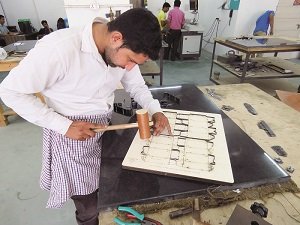
When we last visited Artize Die Makers’ Kundli plant in November 2015, it was undergoing construction. And even though several parts of the facility were still being fixed, the first machine was already installed—a laser-cutter from Cutlite Penta of Italy. Moving on to the present, the factory is now complete with production going on in full swing and 35 workers already on the job.
Die-making is a specialized job and it requires special tools and a skilled workforce. However, what’s crucial is to possess a certain know-how and far-sightedness from the printer who plans to invest in quality dies, which would ultimately pay off in terms of overall quality and the presentation of the cartons produced.
Rahul Luthra, managing director of Artize Die Makers, says the company needs to focus on supplying high-quality dies as there is high demand in the market for quality products. He says, “When we were doing initial market research before venturing into the business of making dies, we found out two essential truths in India—cheap products sell well but quality products sell even better. Cheap can be produced by most and is not exclusive so we decided to stick to quality.”
Customer satisfaction is the top priority for the company at the moment with on-time deliveries of dies with no delays. “Our customers should get their dies delivered on time with proper quality checks and assurance. When dies are not delivered on time, the entire printing process gets delayed, which may result in low productivity for a printer and certain loss at the end of a day. Our objective is to help our customers cut down on their make-ready times, reduce downtimes and to work as fast as possible. If our on-time delivery of dies helps reducing overtime or extra shifts for our customers, we would consider it as our reward.”
Nevertheless, on-time delivery is easier said than done. This is a specialized business which requires heavy investment and skills to run along. To attend to the growing needs of its customers, Artize has invested in a Delta machine from Italy, which cuts rubbers, pertinex and steel counter plates as precisely as possible. Artize has also decided to invest in software from UK-based Impact. “In our constant endeavor to improve quality and reduce time, we have decided to implement software solutions from Impact Group of UK. Once implemented, this software will help us reduce die-making time from about 4 hours to about 2 hours, which should help us double our productivity.”

That’s not all. To take its productivity and quality parameters to the next level, the company plans to invest in another laser die-cutting machine and one more Delta machine. Luthra says, “The current production schedules are not a problem for our existing range of equipment. However, if we do want to multiply our productivity as per market demand, then the situation may not be ideal. So we need to invest in more machines to help scale our business in the imminent future.” All these specialized capital equipment will once again be supplied to Artize by AS Print Aids of Delhi. According to Luthra, “We consider Arun Gandhi of AS Print Aids to be a figure of great support to us. With the untimely and unfortunate demise of one of them, it has been a tremendous loss to the industry as they have helped shape the industry. We would remain associated with them in the long term.”
Artize Die Makers recently participated in two exhibitions—IndiaCorr Expo in Mumbai and Eastern Printpack in Kolkata. “We received tremendous response at both these exhibitions and this shows the latent possibilities in these markets for quality dies. We are already supplying dies to not only customers in India but also to our neighboring countries such as Bangladesh, Mauritius and Eastern European countries and the Middle East. As of now, according to our estimates, only 5% of the market is based on laser dies. By 2022, this figure may go up to 50%. We are determined to attend to the growing needs of our industry and satisfy our customers with our service and performance,” Luthra concludes.









